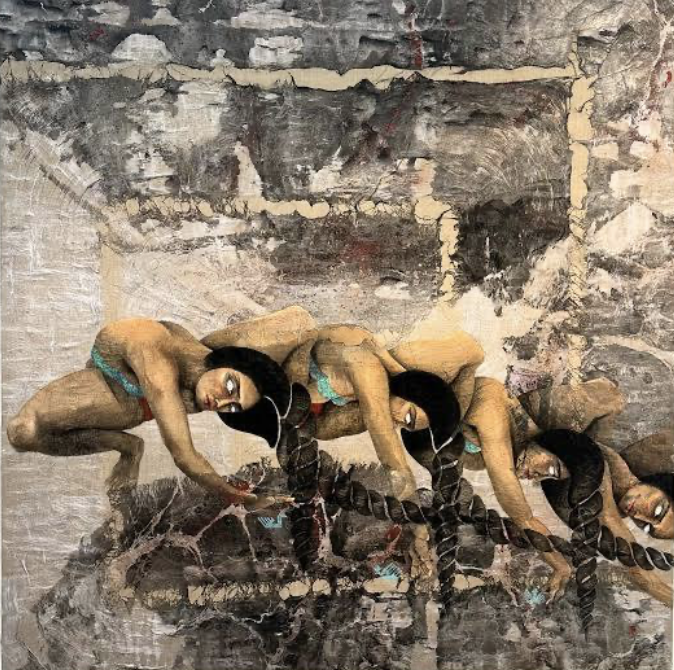 Hayv Kahraman. Rain Birds Ritual, 2025.
Hayv Kahraman. Rain Birds Ritual, 2025.
Oil, acrylic and flax on acrylic.
Enjoying the content on 3QD? Help keep us going by donating now.
 Hayv Kahraman. Rain Birds Ritual, 2025.
Hayv Kahraman. Rain Birds Ritual, 2025.
Oil, acrylic and flax on acrylic.
Enjoying the content on 3QD? Help keep us going by donating now.
by J. M. Tyree
 Morgan Meis and I have been talking about art for years. We’re friends and interlocutors, so I’ll refer to him by first name here for the sake of transparency. Morgan writes about painting; I write about movies. We spent the pandemic exchanging letters with each other about films by Terrence Malick, Lars von Trier, and Krzysztof Kieślowski. These letters were later collected in a mad book called Wonder, Horror, Mystery, in which we spent 366 pages arguing like two flannel-wearing Gen X oldsters sipping lemonade on a porch.
Morgan Meis and I have been talking about art for years. We’re friends and interlocutors, so I’ll refer to him by first name here for the sake of transparency. Morgan writes about painting; I write about movies. We spent the pandemic exchanging letters with each other about films by Terrence Malick, Lars von Trier, and Krzysztof Kieślowski. These letters were later collected in a mad book called Wonder, Horror, Mystery, in which we spent 366 pages arguing like two flannel-wearing Gen X oldsters sipping lemonade on a porch.
I like reading arts criticism that is personal, not too heavy, and accessible to non-specialists, written in a style that is a little bit more intellectual than most American journalism and magazine writing, but a little less jargony and a little more fun to read than academic monographs. Maybe it is possible to dream of creating a form of arts criticism that is itself art. Hardly novel in itself – on the contrary, this idea returns criticism to certain old ways of writing about the arts, and makes a mess of the contemporary academic divisions between criticism, scholarship, and belletristic writing. This book does all of these things.
What Morgan has to say about art makes the world a more interesting place when one reads books like The Grand Valley, the last volume in his trilogy about paintings. The trilogy started with Rubens (The Drunken Silenus), continued with Franz Marc (The Fate of the Animals), and has now culminated with this new book about Joan Mitchell. Apart from Mitchell I strongly dislike the painters Morgan has selected for his triptych. Actually, Rubens is much more interesting than I previously thought, I realized, after reading Morgan’s book, and going to look at Rubens’s terrifying paintings in Munich (which are truly creepy and hellish). I still hate Rubens. Marc does nothing for me, to be honest. Among Mitchell’s paintings Morgan has selected the series of canvases entitled La Grande Vallée. Finally, things were looking up for me as a reader!
Joking aside, the preceding volumes in the trilogy are very compelling reads worth exploring and mulling over, but the trilogy is designed so that each book can be read separately and the reader won’t lose the thread. More generally, I love the idea of a trilogy of arts criticism books – in this economy? – for its simultaneously high-minded and intentionally ridiculous impression of self-mocking and self-serious moves. Refreshing. Read more »
by Charles Siegel
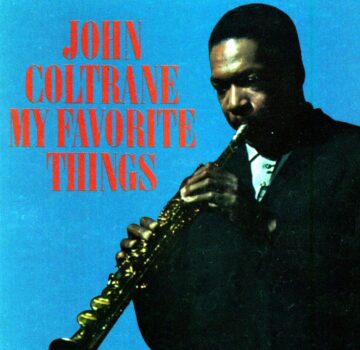
Sixty-five years ago this month, the John Coltrane Quartet entered Atlantic Studios in Manhattan for three days of recording sessions, over the course of a week. It was the first time the band recorded together. The four musicians — Coltrane on tenor and soprano saxophones, McCoy Tyner on piano, Steve Davis on bass and Elvin Jones on drums — remarkably produced enough material for three albums, and then some, in those three sessions. Some of the recordings are jazz classics — “Equinox,” for example, a Coltrane blues composition. Others include beautiful renditions of standards like “Every Time We Say Goodbye,” “Summertime,” and “But Not for Me.”
These three sessions involved intense, concentrated work by musicians at the top of their game. But in just the second song they recorded, on the first day, lightning struck in one take. On Friday afternoon, October 21, 1960 these four men recorded “My Favorite Things” — 13 minutes, 46 seconds of pure transcendence. My Favorite Things (Stereo) (2022 Remaster)
I don’t know how many times I’ve listened to this recording, but it’s got to be hundreds. And after having listened to it so many times, I still can’t describe it in any way that really does it justice. It’s just ineffable.
Most people associate the song with Julie Andrews. She sang it in the movie version of “The Sound of Music.” My Favorite Things from The Sound of Music (Official HD Video) But that movie only came out in 1965. “The Sound of Music” started out, of course, as a Rodgers and Hammerstein musical. It was based on the story of the real-life von Trapp family, as described in the 1949 memoir of its matriarch, Maria Von Trapp. It was first performed on Broadway in November 1959, with Mary Martin as Maria.
In October 1960, then, and even in March of 1961 when the recording was released, “My Favorite Things” was not the chestnut it is today. But Coltrane decided to try it. The version the quartet recorded is entirely different from the original cast recording sung by Mary Martin, or the later movie version by Julie Andrews, both of which are prim and perky. Read more »
I feel a cup slip from my grip then I
see it heading for the floor . . .
………………. —it could be now
I see the morning trees, the jittering
leaves of aspens in a breeze
above our tool shed dancing. . .
………………. —it could be now
I’m reaching for glasses set in rows,
I take the nearest thinking of cool water that
will sate my thirst, I know . . .
………………. —it could be now
Here we are among a group of others
recalling, laughing, being, and someone
asks if I’d like him to refresh my drink
at which point it happens that I think
I’m falling, leaning . . .
………………. —it could be now
Clouds of water vapor passing
overhead, the day is brilliant, sunlight
bouncing from blossoms of Hydrangea
warm and white as slices of my mother’s bread . . .
………………. —it could be now
It then occurs to me, again, the earth is turning,
the sun is burning, daylilies are returning
because you loved them there, grew them,
placed them as you always do, with care, and
I am reaching for your hand once more
and realize it always . . .
………………. —could be now
by Jim Culleny, 10/3/25
Enjoying the content on 3QD? Help keep us going by donating now.
by Christopher Hall

What does it mean to turn somebody into an object, either literally, by killing them, or in a more conceptual sense, by robbing them of freedom of thought and action? This, according to Simone Weil in her celebrated essay on the Iliad, is the central topic of that poem:
Here we see force in its grossest and most summary form – the force that kills. How much more varied in its processes, how much more surprising in its effects is the other force, the force that does not kill, i.e., that does not kill just yet. It will surely kill, it will possibly kill, or perhaps it merely hangs, poised and ready, over the head of the creature it can kill, at any moment, which is to say at every moment. In whatever aspect, its effect is the same: it turns a man into a stone. From its first property (the ability to turn a human being into a thing by the simple method of killing him) flows another, quite prodigious too in its own way, the ability to turn a human being into a thing while he is still alive. He is alive; he has a soul; and yet – he is a thing. An extraordinary entity this – a thing that has a soul. (Mary McCarthy’s translation)
A thing that has a soul. Is this not a rather routine definition of what a human being already is? In one line of thinking, a human being is an object, and no amount of force is needed to make this so. We are the same kind of stuff as rocks, clouds and black holes, even if one feels Weil would very much balk at this description, and insist that the human being, properly understood, is no sort of object at all. Why insist that force makes us into this “extraordinary entity” otherwise? Force may exercise the majority of its workings on the human object, but its ultimate goal and function, in Weil’s view, is an attack on the subject. Unless we are of the opinion that such a subject doesn’t actually exist – and there are plenty around who are – then force does indeed enact something terrible on the human being, whether we subsist, at least in part, as objects or not.
But what does that entail, exactly – the transition from subject to object? Read more »
by Christopher Horner
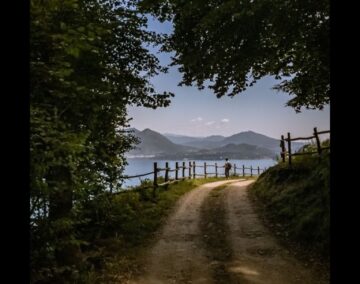
Existentialism was my introduction to the world of philosophy. I was first drawn in by its core idea, that individuals forge their own identities through their actions and, through the values they embrace. This notion held appeal for a young man searching for identity beyond family ties, a philosophy both romantic and invigorating. Like many others, my early intellectual heroes were the post-war French thinkers who seemed to embody these ideals: primarily Sartre, but also Camus, and although I vaguely sensed Camus’ approach to the absurd was different, I clumped him in with Sartre, which was a mistake. Then there was Simone de Beauvoir, whom I relegated to a secondary role: I was wrong about that, too. Those formative years painted existentialism as inherently French and Parisian and I was only dimly aware of other figures like Heidegger, Kierkegaard, and Nietzsche. The literary dimension and imagined Left Bank lifestyles added to existentialism’s allure. The glamour of it all! Where has it gone?
Radical Choice
In retrospect, I find many aspects of Sartrian existentialism problematic. Central among these is the concept of the individual as a ‘radical chooser’—the idea that meaning and value, absent from the world, must be created through acts of choice, thereby affirming value. This amounts to a form of extreme voluntarism: something is deemed good solely because one wills it to be so. “Existence precedes essence”—we become what we do. This is an untenable position.
I have previously discussed this issue of ‘existential choice’ on 3QD and will not elaborate at length here.[1] Briefly, if our choices are radically free, unconstrained by external facts, then any decision is justifiable only by the will of the actor. There are no external criteria for determining whether a choice is ‘right’, only that it is made freely. But then, choices look arbitrary, or they would if that was what happens in real life. People don’t act like that over any but the most trivial choices. Our decisions, our actions, presuppose commitments and frameworks of value, and dilemmas arise precisely because such frameworks are already in place. One may agonise over a moral dilemma, uncertain whether one has chosen rightly, but one cannot choose whether a situation constitutes a dilemma in the first place. Read more »
by Ken MacVey
In my last two columns, I raised issues about certain versions of right-wing libertarianism. In my column “How Yard Sales Could Explain the Rise of Billionaires and Challenge Libertarian Thinking” I argue that the “yard sale model” developed by mathematicians and physicists to explain wealth inequality presents a provocative challenge to philosopher Robert Nozick’s vision of libertarianism as “utopia.” In my column “Crony Capitalism, Milton Friedman’s Contradiction, and Trumpocracy,” I discussed how Milton Friedman’s libertarian program was self-defeating by encouraging business to seek and get government favors inconsistent with a libertarian agenda.
Here I will discuss one of the most touted foundations for libertarianism: self-ownership. The first articulation of the idea of self-ownership is attributed to John Locke in his classic 1690 Second Treatise of Government when he pronounced: “[E]very man has a property in his own person; this nobody has any right to but himself. The labor of his body and the works of his hands we may say are properly his.” Nozick himself traces his libertarianism to Locke. Based upon this mixture of labor with property, rights to other property are established. Ultimately all property rights are derived from self-ownership and property rights ultimately define our fundamental rights as individuals. Accordingly, the nonconsensual taking of property by private force or government taxation is violative of self-ownership and therefore wrong.
What is the Foundation of Self-Ownership and Property Rights?
It has been noted by critics, such as philosopher Thomas Nagel, that Nozick does not lay a foundation to justify the Lockean starting point. I personally have observed that many libertarian writers assert self-ownership as a given without further justification. Libertarian Karl Hess, for example, wrote in his pioneering manifesto “The Death of Politics” that “Libertarianism is the view that each man is the absolute owner of his life, to use and dispose as he sees fit.” That’s the extent of his justification of the self-ownership premise. Locke’s justification likewise does not go much further than its pronouncement. Nevertheless, the notion of self-ownership does have an intuitive appeal as a slogan. Versions of the idea can resonate outside libertarian circles, such as when women assert their reproductive rights (“I have the right to control my own body”).
There are some important values of autonomy the idea of self-ownership tries to capture. But there are problems with the idea. Read more »
by Nils Peterson
Reading into and about Wallace Stevens this morning I find this quotation, “The deepening need for words to express our thoughts and feelings…loving them and feeling them, makes us search for the sound of them, for a finality, a perfection, an unalterable vibration….” I’m an endless rewriter and surely this is part of the reason for that, getting the sound exactly right even if it means a shift in meaning, but I thought as I read those words of my first pure experience of the delight in sound divorced from meaning. I should add as an adult because I loved word-sounds as a child “Hey diddle diddle,” “with a knick-knack paddy whack,” Rumplestiltskin.
At this time I was sitting at my desk working as Assistant Director of Admissions at Upsala College in East Orange, New Jersey [auto-correct wanted to make it Upscale College which it wasn’t though it was a good school] reading a lot of Faulkner in my spare time, thinking of myself essentially a fiction person though I had written some traditional poems and had bouts of strange love with one poem and another. A phrase out of nowhere flew in one ear and almost out the other before I managed to catch it, “crew went the curlew as it flew in a curlicue.” I can’t explain the delight it gave me. I loved the sound of it, the shape of it, the feel of it though clearly it was meaningless. But meaning was irrelevant. I don’t know if I wrote it down, but memory found some way of retaining it. I would take it out now and then and feel it, almost like pebble one finds at a beach and carries in a pocket for awhile for comfort.
Almost sixty years later, I found a place to put it. I was poet laureate of Santa Clara County in California. There were half a dozen other laureates around and we were going to do a reading together. I suggested that it would be fun to all write something of the same kind and suggested a piece of exactly 100 words. It could be prose or lined, whatever shape or form, but it had to be exactly 100 words including the title. The ocean of words and word combination possibilities is so large that some kind of shape-giving limitation is a gift not a handicap. By making things harder, it makes things easier. Read more »
by David Beer
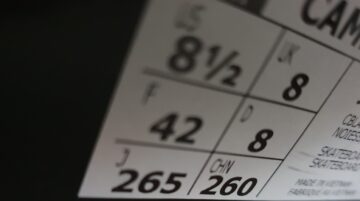 The other day, in a cavernous sports superstore, I thought of J.G. Ballard. Echoey. Compartmentalised. Fluorescent. Stuffed with product. It was, probably quite obviously, the sort of place Ballard might have imagined the norms of society suddenly collapsing in on themselves, unable to carry their own contradictions.
The other day, in a cavernous sports superstore, I thought of J.G. Ballard. Echoey. Compartmentalised. Fluorescent. Stuffed with product. It was, probably quite obviously, the sort of place Ballard might have imagined the norms of society suddenly collapsing in on themselves, unable to carry their own contradictions.
Banal yet shiny, ordered yet unstable, glowing yet unspectacular. It just seemed a ripe setting for a sequel to his 1975 novel High Rise, in which, famously, a luxury tower block became the scene of a destructive uprising against the hierarchical social stratification that its vertical floors represented. Or, maybe I could be trapped alone in the store, unable to escape its automatic doors, in a twist on Concrete Island, the 1974 tale of the motorist marooned in a dead-space between intersecting motorways.
I was welcomed by a basket of varied coloured footballs and a rack of monochrome mid-calf socks. To the side an array of baseball caps – each a slight variation on the last.
The store swung around to the left in an L shaped-layout. A dog-leg left, perhaps leading to the golf section. There was a second floor too, with equal square footage. Desolate. In the distance, two racks of sporty house-slippers.
Moving through what I imagined the store planners refer to as zones, everything arrived in glances. Fleeting eye movements, taking in the many minute differences. Rapid and brief views of garments momentarily visible, as lines of sight allowed. Flashes of light off mirrors. High wattage signs. The light was artificially bright. Yet there seemed to be no shadows.
The folds of products are deep-lined. The rails packed tight. The display shelves carry the weight of consumables. Lots of things for sport, and many more besides. Some faux sheepskin boots. Decorative desert boots. A NASA emblazoned bomber jacket – for when you wish to look like an astronaut attending a post-flight press conference. My attention jumped between fuzzy fragments, bits and pieces.
All these things and no algorithm to tell me what I should purchase. That is what I was missing in the actual concrete shop. I had no automated prediction of my taste. I had to make my own decisions. Trying to navigate the mass of items the absence of automation became obvious. I was manual, analogue shopping. Read more »
by Ed Simon

We read for many reasons – to be edified and educated, entertained and enlightened; but let’s be honest, sometimes we just want a nice, strong cup of tea. Whether there is some malignancy in my soul or not, the novels which I read over the past two months greatly indulged my not-so-secret inner energy vampire. Accounts of embarrassments, addictions, traumas, affairs and dramatic scenes. My currency through these books, all of them recently published, was that of cringe. And I loved them. Because the thing with tea is that it’s not just a little treat for the part of us that loves the spectacle of human debasement, but that there is some spiritual nourishment that comes along with it.
Nineteenth-century historian Henry Thomas Buckle said that “gossip is the lowest form of communication,” but that’s the sour grapes of a long-dead man that none of us know anything about other than that snobbish opinion. Because gossip can be fantastic. At its core, there can be a moral aspect to gossip. Yes, there is an element of judgement, as well as one of gratitude that the subject of discussion isn’t you. But there are lessons to be learned, ethical and human lessons, in stories where the individual train goes off the track. Besides, a central aspect of fiction is precisely this investigation of the contours of human behavior at its most embarrassing, it’s most desperate and ridiculous. An element of the memento mori in gossip and the literature of human interaction at its most shaky, vulnerable, and attenuated. Of human behavior at its most abjectly messy.
Zoe Dubno’s Happiness and Love, released in September of this year, is a consummate cup of tea. Written as a visceral first-person monologue from an anonymous narrator, a New York arts writer who has only just returned from a London exile to attend a friend’s funeral and a dinner honoring a famous actress unknown to all of the literati whom she used to consider compatriots, the voice of Happiness and Love evokes stream-of-consciousness (but not entirely). The novel is written in long, rollicking, run-on sentences with no chapter breaks; in fact, with no paragraph breaks at all. The narrator has a tendency to repeat the same observations two or three or eight times, or to contradict herself, or to argue with various ever-shifting positions in her own mind. Far from being exhausting, which my description admittedly might make it sound, Dubno’s voice is exhilarating. Read more »
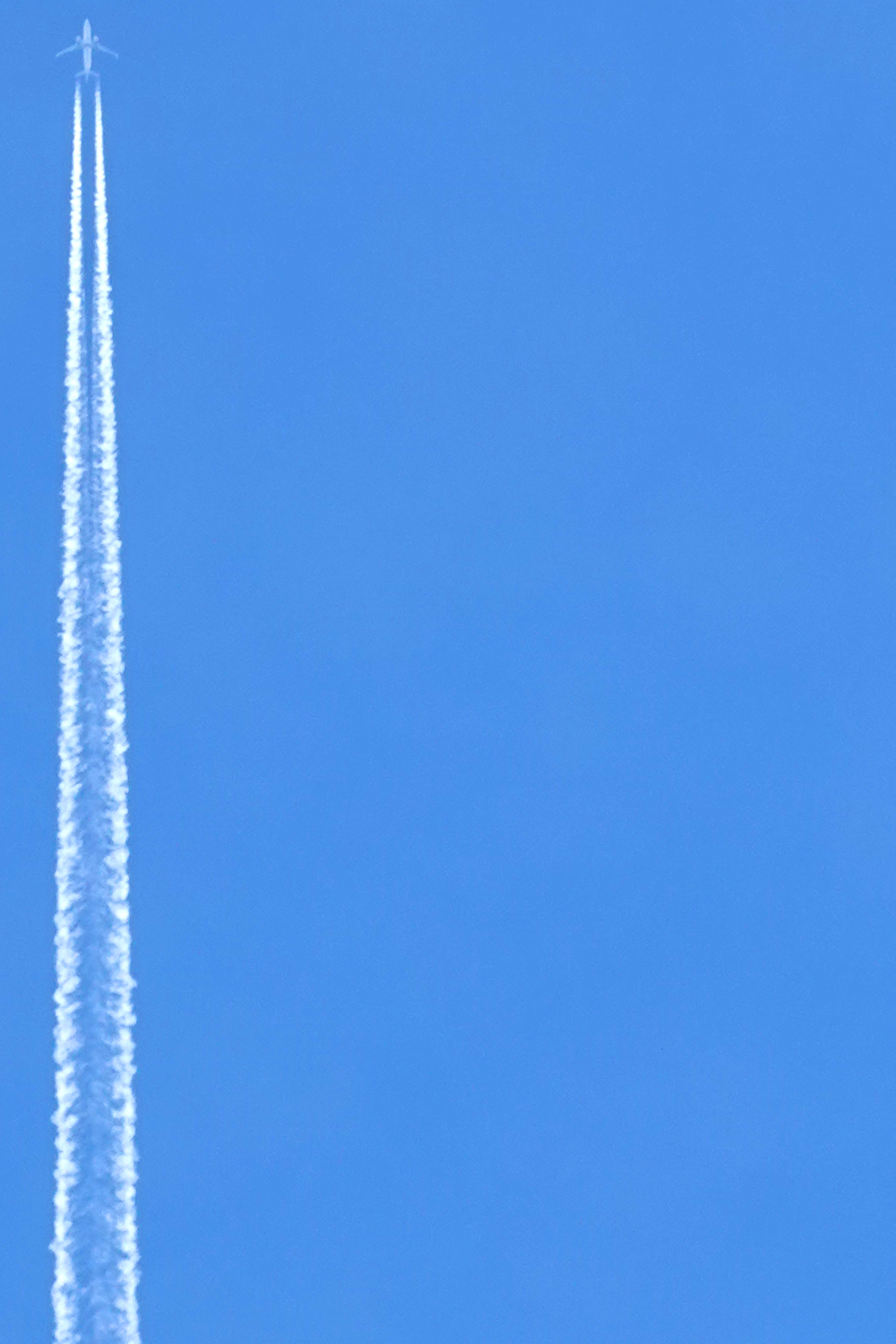
Just a jet over Franzensfeste, South Tyrol.
Enjoying the content on 3QD? Help keep us going by donating now.
by Ashutosh Jogalekar
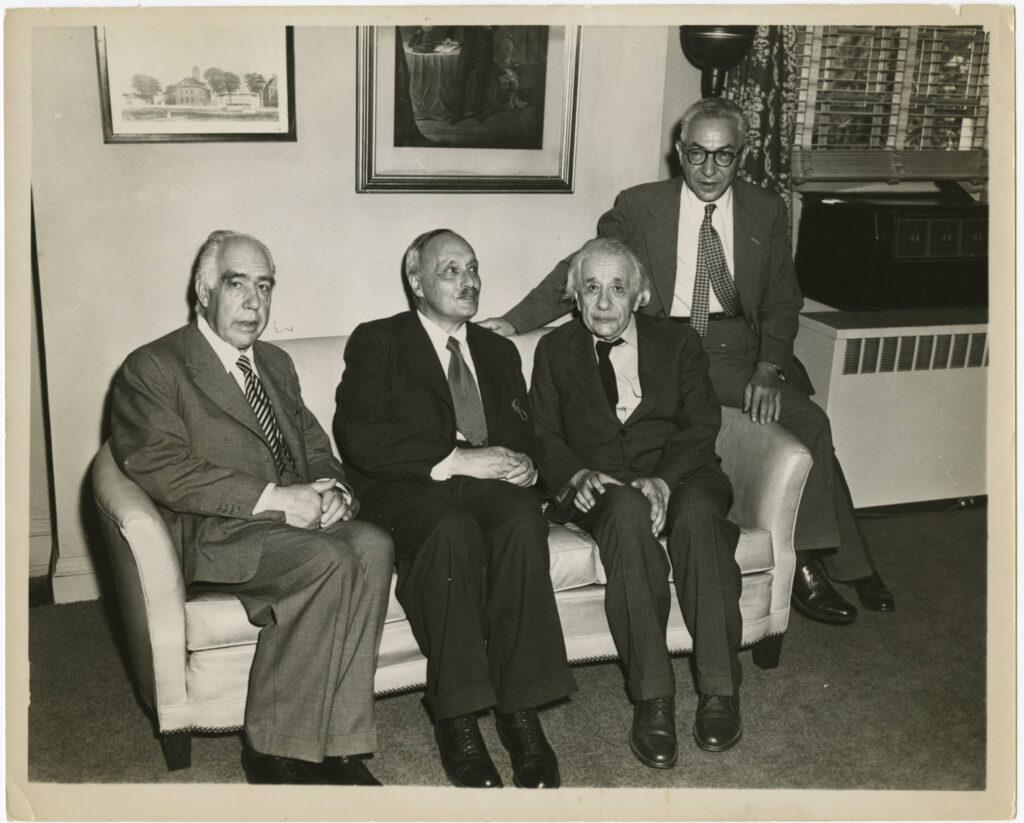
In every generation, young people find causes to champion. Today’s students rally against wars in foreign lands, the environmental record of large companies, the entanglement of Silicon Valley with the Pentagon and China, or the human rights policies of nations like China. These are important causes. In a free country like the United States, protest is not only permitted but celebrated as part of our civic DNA. In fact in a democracy it’s essential: one only has to think of how many petitions and protests were undertaken by women suffragists, by the temperance and the labor movements and by abolitionists to bring about change.
The question is never whether one has the right to protest. The question is how to protest well.
In recent years, I have watched demonstrations take forms that seem more interested in confrontation than persuasion: blocking officials and and other civilians from entering buildings, occupying offices, shouting down speakers, harassing bystanders on their way to work, even destroying property. These actions may satisfy the passions of the moment, but they rarely strengthen the cause. More often they alienate potential allies, harden the opposition, and give critics an excuse to dismiss the substance of the protest altogether. The tragedy is that the cause itself may be just, but the manner of advocacy makes it harder, not easier, for others to listen.
A historical parallel makes the case well. Read more »
by Kyle Munkittrick
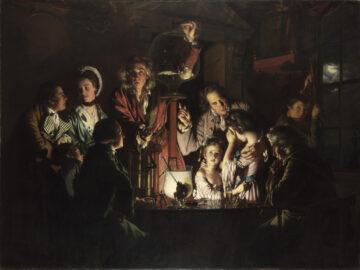
Two types of people are very worried about global fertility — social conservatives and Silicon Valley weirdos. I have the rare privilege of having been both at one point in my life, neither at the same time, and, how apropos, I also have training in bioethics. This is my moment.
Pro-natalists want more babies. They argue that total fertility rates being below replacement level is really bad. They’re very probably right. Unfortunately, the conservatives and weirdos not only almost perfectly oppose and cancel out each other, but are also tying their own rhetorical shoelaces together.
The problem of low fertility is a combination of social and technological barriers. Social conservatives tend to want social solutions and oppose technological ones. The Silicon Valley weirdos tend to want the technological solutions and oppose the social options. Combined, both groups end up failing to convince each other and skeptical normies. Who needs anti-natalists when you’ve got pro-natalists like these?
As a result most normal people think the solution fertility problem is obvious. They are wrong. If you think it’s obvious, read Dr. Alice Evan’s interview with Ross Douthat, her blog on Substack, or these threads by @StatisticUrban. If it’s not obvious, what are the probable causes? Read more »
by Lei Wang

If there’s ever an apocalypse, I’ve told my friends, please sacrifice me for your continued survival. Eat me early on, while I still have viable meat. Don’t be shy. I’m not offering out of selflessness; I’d just rather not suffer. I am afraid something might be wrong with the survival part of my brain. After all, just as there is attachment to existence, there is attachment too to non-existence. I am scared of many things, but death itself is not one of them. I fear living more.
I am afraid of injury, of poverty, of failure to meet my own potential—that yawning maw between who I am and who I imagine I could be—most of all of lovelessness, perhaps the root of all fears. Because I guess I still don’t get it. I don’t get how we’re supposed to only love certain people, the ones we know, and not others, though I am as guilty of this as anyone, if not more. How even then, unless you are given permission or related by blood or unless they really need your help in some unequivocal way, you are still supposed to hide your love for the ones you know, lest you overwhelm them. I don’t know why we can love someone and then stop. Or why I’m still trying to make noises of love to people who aren’t making noises of love back. I don’t understand hunger when there is such abundance, when love is free.
To love is to take someone else as part of you, the spiritual teacher Teal Swan says: a form of returning to the wholeness. When you love someone, you are no longer separately acting out of your own self-interests, or your self-interest naturally expands to include those you love. But where is the line between that and codependency, a lack of boundaries?
Mostly, I still don’t get why we can’t just hang out with the people we like, all the time, and preferably somewhere in Italy. Why do we live in different cities? Why is there such a thing as work? Why all these walls? Or space-time at all? These are rather childish questions, I know. Read more »
by Sherman J. Clark
 Dante begins The Divine Comedy in a dark wood, lost. He cannot see the way forward. His journey out of confusion and despair depends on a guide—not just Virgil, who leads him through Hell and Purgatory, but ultimately Beatrice, whose beauty awakens in him a love that points beyond itself. Beatrice is not simply an object of desire. She is a source of orientation, a reminder that desire itself can be educated, elevated, and directed toward what is most real and most nourishing.
Dante begins The Divine Comedy in a dark wood, lost. He cannot see the way forward. His journey out of confusion and despair depends on a guide—not just Virgil, who leads him through Hell and Purgatory, but ultimately Beatrice, whose beauty awakens in him a love that points beyond itself. Beatrice is not simply an object of desire. She is a source of orientation, a reminder that desire itself can be educated, elevated, and directed toward what is most real and most nourishing.
We too are often in a kind of dark wood—a thicket of distractions, manipulations, and half-truths. And we are surrounded by guides of a sort—marketers, algorithms, prosperity preachers, podcasters and influencers of every sort, all competing for our attention and trying to shape our desires. But unlike Beatrice, they do not aim to elevate or orient us toward what nourishes. Their purpose is to capture and monetize our attention, to keep us scrolling and buying and craving.
This is not just an annoyance. It is a crisis of desire. Our wants—so deeply bound up with our hopes, our fears, our sense of meaning—are increasingly manufactured to serve others’ ends. If desire is the engine of our striving, we are in danger of running on fuel that corrodes us. Read more »
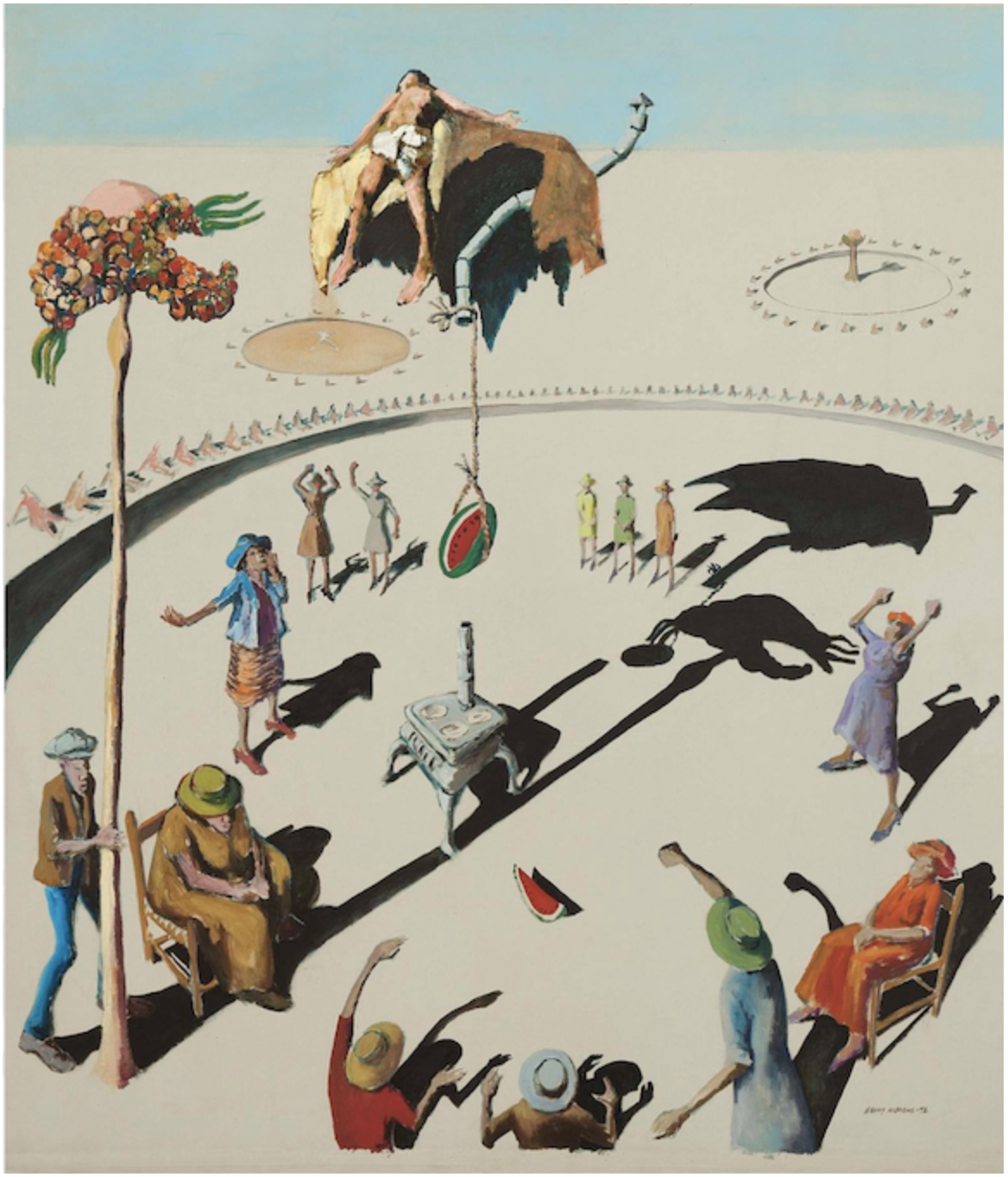 Benny Andrews. Circle Study #2, 1972.
Benny Andrews. Circle Study #2, 1972.
Enjoying the content on 3QD? Help keep us going by donating now.
by Tim Sommers
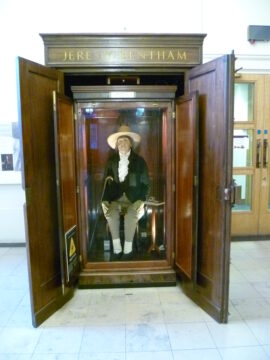
The ends don’t justify the means. Right? But then what does?
Utilitarians say that, of course, the ends justify the means. If the ends can’t justify the means, then nothing can. Utilitarianism is built on the twin pillars of welfarism and consequentialism.
Consequentialism is the view that the morally right thing to do is whatever has the best consequences.
Welfarism is the view that the only thing intrinsically valuable is human happiness, welfare, well-being, having their desires fulfilled, flourishing, or the like.
Utilitarianism calls whatever it is exactly that matters in terms of human good (happiness, having your preferences fulfilled and flourishing are not exactly the same thing) utility. Utility is a technical term for whatever it is that is intrinsically valuable – which has something to do with human happiness
Powerful intuitions support this combination of consequentialism and welfarism. From a consequentialist perspective, to deny the truth of utilitarianism is to be forced to defend the claim that sometimes, given the choice, we should find the worse morally superior to the better. Specifically, that we should sometimes do the thing that has worse consequences – even when we could have done something with better consequences. From the welfarist perspective, to deny utilitarianism is to be forced to defend the claim that we must, at least sometimes, intentionally do things that make everyone overall less happy when we could have done something that would have made people overall more happy.
“During much of modern moral philosophy the predominant systematic theory has been some form of utilitarianism,” John Rawls wrote in A Theory of Justice. “One reason for this is that it has been espoused by a long line of brilliant writers who have built up a body of thought truly impressive in its scope and refinement…Hume and Adam Smith, Bentham and Mill, were social theorists and economists of the first rank; and the moral doctrine they worked out was framed to meet the needs of their wider interests.”
However, all the classical utilitarians had in common that they used two very different kinds of argumentative strategies to bolster the view: one we might call the negative or downward approach, the other, the positive or upwards argument. Read more »
by Jonathan Kujawa
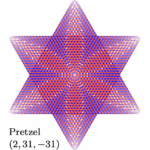 Mathematics is an inexhaustible subject. Every time you think you’ve mined out a vein, you hit a new gem. There is no clear reason why this should be true, but all evidence shows that it is mathematics all the way down [1].
Mathematics is an inexhaustible subject. Every time you think you’ve mined out a vein, you hit a new gem. There is no clear reason why this should be true, but all evidence shows that it is mathematics all the way down [1].
I once saw a talk by a mathematician near retirement who had made numerous influential discoveries over the years. The recurring theme of the talk was how, time after time, he finally understood everything about his favorite corner of mathematics. The joke, of course, was that each new discovery revealed how his previous “complete” understanding still overlooked interesting and important things.
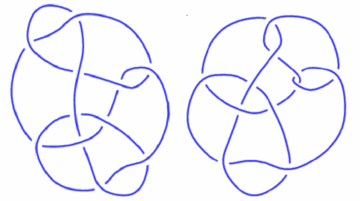
An excellent example of this phenomenon is knot theory. This is the mathematics of figuring out how to distinguish different knots. Two knots could look very different, but could turn out to be the same after some manipulation. Or not! For example, to the right are two knots created by Conway and by Kinoshita-Terasaka. It turns out to be extraordinarily difficult to figure out if they are the same knot or not.
This is one of those kinds of research that politicians and know-nothings love to sneer at. It sounds stupid, trivial, and of no use to anyone. However, if you’re one of those who care about real-world applications, the mathematics of knot theory plays a role in string theory, protein folding, quantum computing, and more.
But if you’re one of those who find math interesting for its own sake, then you’ll be glad to learn that knot theory is a rich vein of mathematics that continually reveals deep, beautiful, and interesting new discoveries. In this essay, I thought I’d share yet another new discovery in knot theory. Longtime readers of 3QD won’t be surprised: we’ve talked about knots many, many, many times over the years. Read more »
Common, simple thoughts are hard to place in
deep context as they rush our minds and hold them fast.
So,
we don’t look in,
but out,
around, and
past.
Too small to be big,
small-thoughts squeeze
between lines
suggesting,
hinting,
asking,
& telling
as the tale unfolds.
To big to be small,
they come off as incidental
while holding a universe
in their grasp.
We wander half-awake through days ignoring
the stupendous humble things each day contains:
—FuturePresentPast & WhatRemains,
the One-Thing
Jim Culleny
7/23/21-Edited 9/28/25
Enjoying the content on 3QD? Help keep us going by donating now.